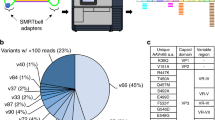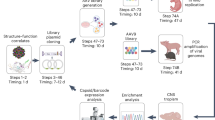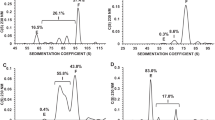Abstract
Vectors based on the adeno-associated virus (AAV) are attractive and versatile vehicles for in vivo gene transfer. The virus capsid is the primary interface with the cell that defines many pharmacological, immunological and molecular properties. Determinants of these interactions are often restricted to a limited number of capsid amino acids. In this study, a portfolio of novel AAV vectors was developed after a structure–function analysis of naturally occurring AAV capsid isolates. Singletons, which are particular residues on the AAV capsid that were variable in otherwise conserved amino acid positions, were found to impact on vector's ability to be manufactured or to transduce. Data for those residues that mapped to monomer–monomer interface regions on the particle structure suggested a role in particle assembly. The change of singleton residues to the conserved amino acid resulted in the rescue of many isolates that were defective on initial isolation. This led to the development of an AAV vector portfolio that encompasses six different clades and 3 other distinct AAV niches. Evaluation of the in vivo gene transfer efficiency of this portfolio after intravenous and intramuscular administration highlighted a clade-specific tropism. These studies further the design and selection of AAV capsids for gene therapy applications.
This is a preview of subscription content, access via your institution
Access options
Subscribe to this journal
Receive 12 print issues and online access
$259.00 per year
only $21.58 per issue
Buy this article
- Purchase on Springer Link
- Instant access to full article PDF
Prices may be subject to local taxes which are calculated during checkout




Similar content being viewed by others
Accession codes
References
Fields BN, Knipe DM, Howley PM . Fields’ Virology, 5th edn Wolters kluwer/Lippincott Williams & Wilkins: Philadelphia, 2007.
Flotte TR, Carter BJ . Adeno-associated virus vectors for gene therapy. Gene Therapy 1995; 2: 357–362.
Wu Z, Asokan A, Samulski RJ . Adeno-associated virus serotypes: vector toolkit for human gene therapy. Mol Ther 2006; 14: 316–327.
Gao GP, Lu Y, Sun X, Johnston J, Calcedo R, Grant R et al. High-level transgene expression in nonhuman primate liver with novel adeno-associated virus serotypes containing self-complementary genomes. J Virol 2006; 80: 6192–6194.
Nathwani AC, Gray JT, McIntosh J, Ng CY, Zhou J, Spence Y et al. Safe and efficient transduction of the liver after peripheral vein infusion of self-complementary AAV vector results in stable therapeutic expression of human FIX in nonhuman primates. Blood 2007; 109: 1414–1421.
Wang L, Calcedo R, Nichols TC, Bellinger DA, Dillow A, Verma IM et al. Sustained correction of disease in naive and AAV2-pretreated hemophilia B dogs: AAV2/8-mediated, liver-directed gene therapy. Blood 2005; 105: 3079–3086.
Sanlioglu S, Monick MM, Luleci G, Hunninghake GW, Engelhardt JF . Rate limiting steps of AAV transduction and implications for human gene therapy. Curr Gene Ther 2001; 1: 137–147.
Thomas CE, Storm TA, Huang Z, Kay MA . Rapid uncoating of vector genomes is the key to efficient liver transduction with pseudotyped adeno-associated virus vectors. J Virol 2004; 78: 3110–3122.
Wang J, Xie J, Lu H, Chen L, Hauck B, Samulski RJ et al. Existence of transient functional double-stranded DNA intermediates during recombinant AAV transduction. Proc Natl Acad Sci USA 2007; 104: 13104–13109.
Gao G, Vandenberghe LH, Alvira MR, Lu Y, Calcedo R, Zhou X et al. Clades of Adeno-associated viruses are widely disseminated in human tissues. J Virol 2004; 78: 6381–6388.
Calcedo R, Vandenberghe LH, Gao G, Lin J, Wilson JM . Worldwide epidemiology of neutralizing antibodies to adeno-associated viruses. J Infect Dis 2009; 199: 381–390.
Scallan CD, Jiang H, Liu T, Patarroyo-White S, Sommer JM, Zhou S et al. Human immunoglobulin inhibits liver transduction by AAV vectors at low AAV2 neutralizing titers in SCID mice. Blood 2006; 107: 1810–1817.
Lin J, Calcedo R, Vandenberghe LH, Figueredo JM, Wilson JM . Impact of preexisting vector immunity on the efficacy of adeno-associated virus-based HIV-1 Gag vaccines. Hum Gene Ther 2008; 19: 663–669.
Zhang TP, Jin DY, Wardrop 3rd RM, Gui T, Maile R, Frelinger JA et al. Transgene expression levels and kinetics determine risk of humoral immune response modeled in factor IX knockout and missense mutant mice. Gene Therapy 2007; 14: 429–440.
Vandenberghe LH, Wang L, Somanathan S, Zhi Y, Figueredo J, Calcedo R et al. Heparin binding directs activation of T cells against adeno-associated virus serotype 2 capsid. Nat Med 2006; 12: 967–971.
Schmidt M, Voutetakis A, Afione S, Zheng C, Mandikian D, Chiorini JA . Adeno-associated virus type 12 (AAV12): a novel AAV serotype with sialic acid- and heparan sulfate proteoglycan-independent transduction activity. J Virol 2008; 82: 1399–1406.
Schmidt M, Grot E, Cervenka P, Wainer S, Buck C, Chiorini JA . Identification and characterization of novel adeno-associated virus isolates in ATCC virus stocks. J Virol 2006; 80: 5082–5085.
Schnepp BC, Jensen RL, Chen CL, Johnson PR, Clark KR . Characterization of adeno-associated virus genomes isolated from human tissues. J Virol 2005; 79: 14793–14803.
Schnepp BC, Jensen RL, Clark KR, Johnson PR . Infectious molecular clones of adeno-associated virus isolated directly from human tissues. J Virol 2009; 83: 1456–1464.
Gao G, Alvira MR, Somanathan S, Lu Y, Vandenberghe LH, Rux JJ et al. Adeno-associated viruses undergo substantial evolution in primates during natural infections. Proc Natl Acad Sci USA 2003; 100: 6081–6086.
Gao GP, Alvira MR, Wang L, Calcedo R, Johnston J, Wilson JM . Novel adeno-associated viruses from rhesus monkeys as vectors for human gene therapy. Proc Natl Acad Sci USA 2002; 99: 11854–11859.
Govindasamy L, Padron E, McKenna R, Muzyczka N, Kaludov N, Chiorini JA et al. Structurally mapping the diverse phenotype of adeno-associated virus serotype 4. J Virol 2006; 80: 11556–11570.
Nam HJ, Lane MD, Padron E, Gurda B, McKenna R, Kohlbrenner E et al. Structure of Adeno-Associated virus serotype 8, a gene therapy vector. J Virol 2007; 81: 12260–12271.
Xie Q, Bu W, Bhatia S, Hare J, Somasundaram T, Azzi A et al. The atomic structure of adeno-associated virus (AAV-2), a vector for human gene therapy. Proc Natl Acad Sci USA 2002; 99: 10405–10410.
Wu Z, Asokan A, Grieger JC, Govindasamy L, Agbandje-McKenna M, Samulski RJ . Single amino acid changes can influence titer, heparin binding, and tissue tropism in different adeno-associated virus serotypes. J Virol 2006; 80: 11393–11397.
Kern A, Schmidt K, Leder C, Muller OJ, Wobus CE, Bettinger K et al. Identification of a heparin-binding motif on adeno-associated virus type 2 capsids. J Virol 2003; 77: 11072–11081.
De BP, Heguy A, Hackett NR, Ferris B, Leopold PL, Lee J et al. High levels of persistent expression of alpha1-antitrypsin mediated by the nonhuman primate serotype rh.10 adeno-associated virus despite preexisting immunity to common human adeno-associated viruses. Mol Ther 2006; 13: 67–76.
Arbetman AE, Lochrie M, Zhou S, Wellman J, Scallan C, Doroudchi MM et al. Novel caprine adeno-associated virus (AAV) capsid (AAV-Go.1) is closely related to the primate AAV-5 and has unique tropism and neutralization properties. J Virol 2005; 79: 15238–15245.
Lochrie MA, Tatsuno GP, Arbetman AE, Jones K, Pater C, Smith PH et al. Adeno-associated virus (AAV) capsid genes isolated from rat and mouse liver genomic DNA define two new AAV species distantly related to AAV-5. Virology 2006; 353: 68–82.
Schmidt M, Katano H, Bossis I, Chiorini JA . Cloning and characterization of a bovine adeno-associated virus. J Virol 2004; 78: 6509–6516.
Bossis I, Chiorini JA . Cloning of an avian adeno-associated virus (AAAV) and generation of recombinant AAAV particles. J Virol 2003; 77: 6799–6810.
Royo NC, Vandenberghe LH, Ma JY, Hauspurg A, Yu L, Maronski M et al. Specific AAV serotypes stably transduce primary hippocampal and cortical cultures with high efficiency and low toxicity. Brain Res 2008; 1190: 15–22.
Limberis MP, Vandenberghe LH, Zhang L, Pickles RJ, Wilson JM . Transduction efficiencies of novel AAV vectors in mouse airway epithelium in vivo and human ciliated airway epithelium in vitro. Mol Ther 2009; 17: 294–301.
Cearley CN, Vandenberghe LH, Parente MK, Carnish ER, Wilson JM, Wolfe JH . Expanded repertoire of AAV vector serotypes mediate unique patterns of transduction in mouse brain. Mol Ther 2008; 16: 1710–1718.
Allocca M, Mussolino C, Garcia-Hoyos M, Sanges D, Iodice C, Petrillo M et al. Novel adeno-associated virus serotypes efficiently transduce murine photoreceptors. J Virol 2007; 81: 11372–11380.
Rabinowitz JE, Bowles DE, Faust SM, Ledford JG, Cunningham SE, Samulski RJ . Cross-dressing the virion: the transcapsidation of adeno-associated virus serotypes functionally defines subgroups. J Virol 2004; 78: 4421–4432.
Nam HJ, Lane MD, Padron E, Gurda B, McKenna R, Kohlbrenner E et al. Structure of adeno-associated virus serotype 8, a gene therapy vector. J Virol 2007; 81: 12260–12271.
Sonntag F, Bleker S, Leuchs B, Fischer R, Kleinschmidt JA . Adeno-associated virus type 2 capsids with externalized VP1/VP2 trafficking domains are generated prior to passage through the cytoplasm and are maintained until uncoating occurs in the nucleus. J Virol 2006; 80: 11040–11054.
Cline J, Braman JC, Hogrefe HH . PCR fidelity of pfu DNA polymerase and other thermostable DNA polymerases. Nucleic Acids Res 1996; 24: 3546–3551.
Smuda JW, Carter BJ . Adeno-associated viruses having nonsense mutations in the capsid genes: growth in mammalian cells containing an inducible amber suppressor. Virology 1991; 184: 310–318.
Chen CL, Jensen RL, Schnepp BC, Connell MJ, Shell R, Sferra TJ et al. Molecular characterization of adeno-associated viruses infecting children. J Virol 2005; 79: 14781–14792.
Lopez-Bueno A, Mateu MG, Almendral JM . High mutant frequency in populations of a DNA virus allows evasion from antibody therapy in an immunodeficient host. J Virol 2003; 77: 2701–2708.
Shackelton LA, Parrish CR, Truyen U, Holmes EC . High rate of viral evolution associated with the emergence of carnivore parvovirus. Proc Natl Acad Sci USA 2005; 102: 379–384.
Lopez-Bueno A, Villarreal LP, Almendral JM . Parvovirus variation for disease: a difference with RNA viruses? Curr Top Microbiol Immunol 2006; 299: 349–370.
Wu P, Xiao W, Conlon T, Hughes J, Agbandje-McKenna M, Ferkol T et al. Mutational analysis of the adeno-associated virus type 2 (AAV2) capsid gene and construction of AAV2 vectors with altered tropism. J Virol 2000; 74: 8635–8647.
Taymans JM, Vandenberghe LH, Haute CV, Thiry I, Deroose CM, Mortelmans L et al. Comparative analysis of adeno-associated viral vector serotypes 1, 2, 5, 7, and 8 in mouse brain. Hum Gene Ther 2007; 18: 195–206.
Hall T . BioEdit: a user-friendly biological sequence alignment editor and analysis program for Windows 95/98/NT. Nucl Acids Symp Ser 1999; 41: 95–98.
Kumar S, Tamura K, Nei M . MEGA3: Integrated software for Molecular Evolutionary Genetics Analysis and sequence alignment. Brief Bioinform 2004; 5: 150–163.
Jones TA, Zou JY, Cowan SW, Kjeldgaard M . Improved methods for building protein models in electron density maps and the location of errors in these models. Acta Crystallogr A 1991; 47 (Pt 2): 110–119.
Acknowledgements
Supported by R01-GM082946 (MA-M), P30-DK-47757, P01-HL-059407, P01-HL-051746 and grants from GlaxoSmithKline Pharmaceuticals, Inc. and the Cystic Fibrosis Foundation (JMW). LV and GPG hold patents on technology described in this paper. JMW is an inventor on patents licensed to various biopharmaceutical companies including ReGenX for which he has equity in, consults for and receives a grant from.
Author information
Authors and Affiliations
Corresponding author
Additional information
Supplementary Information accompanies the paper on Gene Therapy website (http://www.nature.com/gt)
Rights and permissions
About this article
Cite this article
Vandenberghe, L., Breous, E., Nam, HJ. et al. Naturally occurring singleton residues in AAV capsid impact vector performance and illustrate structural constraints. Gene Ther 16, 1416–1428 (2009). https://doi.org/10.1038/gt.2009.101
Received:
Revised:
Accepted:
Published:
Issue Date:
DOI: https://doi.org/10.1038/gt.2009.101
Keywords
This article is cited by
-
Rationally designed AAV2 and AAVrh8R capsids provide improved transduction in the retina and brain
Gene Therapy (2018)
-
Development and rescue of human familial hypercholesterolaemia in a xenograft mouse model
Nature Communications (2015)
-
AAV ancestral reconstruction library enables selection of broadly infectious viral variants
Gene Therapy (2015)
-
Improving clinical efficacy of adeno associated vectors by rational capsid bioengineering
Journal of Biomedical Science (2014)
-
Different protein composition and functional properties of adeno-associated virus-6 vector manufactured from the culture medium and cell lysates
Molecular Therapy - Methods & Clinical Development (2014)



